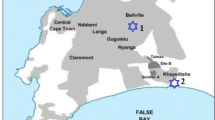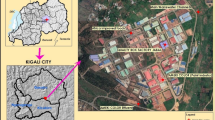Abstract
Discharging industrial waste into water bodies without any treatment is the main source of water pollution. The purpose of this study is to analyze the amount of physicochemical of industry effluents or wastes emitted in streams and rivers in towns of Oromia Special Zones Surrounding Finfinne. Sampling and preserving wastewater was based on American Public Health Association (APHA, Standard methods for the examination of water and wastewater, American Public Health Association, Washington, D.C, 1999). A composite sampling method was employed to collect industry wastewater sample and there by determine the concentration of pH, electric conductivity, chemical oxygen demand Total nitrogen, total phosphorus, and water temperature using ultraviolent atomic spectrophotometer, pH meter, and conductivity meter. The results revealed values of all sampling points were significantly different. The sampling points of Sululta of site 2 and site 5, Gelan of site2 and site 5 and Burayu of site4 were not within the pH ranges of United states Environment Protection Agency (United States environmental protection agency, USEPA (2009). National primary drinking water regulation) depicting the water not safe drinking and irrigation purposes. The low mean pH value at Sabata sampling site of3. The results of nutrient showed all study sites and sampling points seriously polluted by Total nitrogen and Total Phosphorus. Therefore, the industrial effluents were affected water quality, human, aquatic health, environmental pollution and thereby need mitigation measures of sustainable monitoring and supervision of untreated release of industry waste into the environment, phytoremediation of affected streams and rivers, awareness creation for community and advising firm owners to install industry waste treatment plants.

Similar content being viewed by others
References
Alvarez-Cobelas M, Angeler DG, Sánchez-Carrillo S (2008) Export of nitrogen from catchments: a worldwide analysis. Environ Pollut 156(2):261–269
APHA (1999) Standard methods for the examination of water and wastewater, 21st edn. American Public Health Association, Washington, D.C
Bwalya E (2015) Assessment of water quality in urban rivers: a case study of Mansa river in Luapula province of Zambia. University of Zimbabwe faculty of engineering department of Civil engineering (MSc Thesis)
Compulsory Ethiopian standard (2013). Drinking water–specification. Ethiopian standards agency (first edition)
European union (1998) Drinking water quality standards
Fondriest environmental (2013) Inc pH of Water. Fundamentals of environmental measurements. Available online: http://www.fondriest.com/environmental-measurements/parameters/water-quality/ph/ Accessed on 27 September 2018
EPA/UNIDO (2003). The environmental protection authority and the United Nations industrial development organization. Guideline Ambient Environment Standards for Ethiopia, Addis Ababa
Ferezer Eshetu (2012) Physico-chemical pollution pattern in Akaki river basin, Addis Ababa, Ethiopia. Stockholm University, pp 1–38
Fakayode S (2005) Impact assessment of industrial effluent on water quality of the receiving. Alaro River, in Ibadan, Nigeria
Julian KT, Marianne S, Shaun R (2018) Contaminated groundwater sampling and quality control of water analyses. Environmental Geochemistry, 2nd ed.; British Geological Survey: Nottingham, UK. pp 25–45
Kaur A, Vats S, Rekhi S, Bhardwaj A, Goel J, Tanwar RS, Gaur KK (2010) Physico-chemical analysis of the industrial effluents and their impact on the soil microflora. Procedia Environ Sci 2:595–599
Liu Y, Zhu Y, Qiao X, Zheng B, Chang S Fu Q (2018) Investigation of nitrogen and phosphorus contents in water in the tributaries of Danjiangkou Reservoir. ROYAL SOCIETY OPEN SCIENCE, pp 5–6
LVEMP (2002) Biological indicators in environ-mental protection. Chapman and Hall, London
Javier Mateo-Sagasta, Sara Marjani Zadeh and Hugh Turral (2017) Water pollution from agriculture: a global review. pp 11–13
Milkiyas T, Mulugeta K, Bayeh A (2011) Bacteriological and physic-chemical quality of drinking water and hygiene-sanitation practices of the consumers in Bahir Dar city Ethiopia. Ethiopia J Health Sci 22:19–26
Mueller-Warrant GW, Griffith SM, Whittaker GW, Banowetz GM, Pfender WF et al (2012) Impact of land use patterns and agricultural practices on water quality in the Calapooia River basin of western Oregon. J Soil Water Conserv 67(3):183–201
Ohioma I, Luke NO, Amraibure O (2009) Studies on the pollution potential of wastewater from textile processing factories in Kaduna. Nigeria J Toxicol Environ Health Sci 1:34–37
Oparaocha ET, Iroegbu OC, Obi RK (2011) Assessment of quality of drinking water sources in the federal university of technology, owerri, imo state Nigeria. J Appl Biosci 32:1964–1976
Osibanjo O, Daso AP, Gbadebo AM (2011) The impact of industries on surface water quality of River Ona and River Alaro in Oluyole Industrial Estate,Ibadan, Nigeria. Afr J Biotechnol 10(4):696–702. http://www.academicjournals.org/AJB
Ranade VV, Bhandari VM (2014) Chapter 1 chemical engineering and process development division. In: Industrial Wastewater Treatment, Recycling, and Reuse: An Overview; CSIR-National Chemical Laboratory: Pune, India. pp 1–80
Sewvandi GA, Adikary SU (2011) Removal of heavy metals from wastewater using chitosan. Soc Soc Manag Syst Int J 7:1–8
Shepard R (2000) Nitrogen and phosphorus management on Wisconsin farms: lessons learned for agricultural water quality programs. J Soil Watershed Conserv 55(1):63–68
Sulaiman AA, Attalla E, Sherif MAS (2016) Water pollution: source and treatment. Am J Environ Eng 6:88–98
Tamiru A, Dagnachew L, Tenalem A (2005) Hydrology, water quality and the degree of ground water vulnerability to pollution in Addis Ababa, Ethiopia. Addis Ababa: UNEP/UNESCO/UN HABTATE /ECA.
Tassew A (2007) Assessment of biological integrity using physico-chemical parameters and macro invertebrate community index along Sebeta river. Thesis, School of Graduate Studies, Addis Ababa University, Ethiopia. MSc
UNU-EHS/UNEP (2013). International water quality guidelines for ecosystems
United States environmental protection agency, USEPA (2009). National primary drinking water regulation.
Wakawa RJ, Uzairu A, Kagbu JA, Balarabe ML (2008) Impact assessment of effluent discharge on physico-chemical parameters and some heavy metal concentrations in surface water of River Challawa Kano. Nigeria Afr J Pure Appl Chem 2:100–106
WHO (2011) Guidelines for drinking-water quality-4th ed
World Health Organization, WHO (2011). Guideline for drinking water quality: fourth edition incorporating the first addendum.
Xie YX, Xiong ZQ, Xing GX, Sun GQ, Zhu ZL (2007) Assessment of nitrogen pollutant sources in surface waters of Taihu Lake region. Pedosphere 17(2):200–208
Author information
Authors and Affiliations
Corresponding author
Ethics declarations
Conflict of interest
Threre is no conflict of interest among authors.
Additional information
Editorial responsibility: R Saravanan.
Rights and permissions
Springer Nature or its licensor (e.g. a society or other partner) holds exclusive rights to this article under a publishing agreement with the author(s) or other rightsholder(s); author self-archiving of the accepted manuscript version of this article is solely governed by the terms of such publishing agreement and applicable law.
About this article
Cite this article
Jagemma, M., Worku, H., Gemeda, F.T. et al. Variability in space effects of industrial wastewater on river physicochemical characteristics in a sample of towns of Oromia. Int. J. Environ. Sci. Technol. 20, 13299–13306 (2023). https://doi.org/10.1007/s13762-023-04874-0
Received:
Revised:
Accepted:
Published:
Issue Date:
DOI: https://doi.org/10.1007/s13762-023-04874-0




